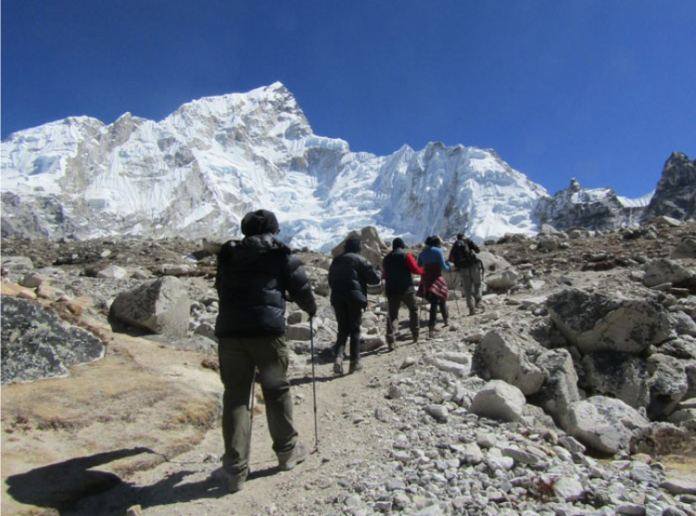The Everest region in Nepal stands as a testament to nature’s grandeur, offering some of the most spectacular trekking opportunities on the planet. For adventure enthusiasts and mountain lovers, the allure of walking in the shadow of the world’s highest peak is irresistible. While the classic Everest Base Camp (EBC) trek remains the most popular option, several variations cater to different preferences, time constraints, and adventure appetites. This article explores three distinctive treks in the Everest region: the Short Everest Base Camp Trek, the challenging Everest Three High Pass Trek, and the historic Jiri to EBC Trek.
Short Everest Base Camp Trek: Time-Efficient Adventure
The Short Everest Base Camp Trek has emerged as a perfect solution for trekkers with limited vacation time but unlimited enthusiasm for experiencing the majesty of the Himalayas. This condensed itinerary typically spans 10-12 days, compared to the traditional 14-16 day journey, while still delivering the quintessential Everest experience.
Key Features
The trek begins with the exhilarating flight to Lukla, often described as one of the world’s most dramatic airports. From there, trekkers follow a well-established route through picturesque Sherpa villages, ancient monasteries, and breathtaking landscapes. Despite its shortened timeline, this trek doesn’t compromise on the highlights:
- Exploration of Namche Bazaar, the vibrant Sherpa capital
- Views of iconic peaks including Ama Dablam, Thamserku, and Lhotse
- Cultural immersion in traditional Sherpa villages
- The ultimate reward: reaching Everest Base Camp (5,364m) and Kala Patthar (5,550m) for unobstructed views of Mt. Everest
The Short Everest Base Camp Trek achieves its efficiency through carefully planned itineraries that minimize acclimatization days while maintaining safety standards. Some variations may include helicopter returns from high points, further reducing the duration without sacrificing the experience.
Ideal For
This trek is particularly suitable for:
- Professionals with limited vacation time
- Physically fit trekkers with previous hiking experience
- Those seeking the Everest experience without committing to extended journeys
- Trekkers visiting Nepal as part of a broader Asian itinerary
Everest Three High Pass Trek: The Ultimate Challenge
For seasoned trekkers seeking a more demanding adventure, the Everest Three High Pass Trek presents the ultimate challenge in the region. This comprehensive circuit traverses three passes above 5,000 meters—Kongma La (5,535m), Cho La (5,420m), and Renjo La (5,340m)—offering a truly immersive Himalayan experience away from the more crowded trails.
The Adventure Unfolds
This 18-21 day journey tests physical endurance and mental fortitude while rewarding trekkers with unparalleled panoramas and a profound sense of achievement. The circuit typically follows a counter-clockwise direction, tackling Kongma La first when trekkers are freshest, then proceeding to Cho La and finally Renjo La.
The trek encompasses all the highlights of the traditional EBC route plus:
- Remote valleys rarely visited by standard trekkers
- Gokyo Lakes, a series of turquoise glacial lakes
- Gokyo Ri (5,357m), offering some argue even better views of Everest than Kala Patthar
- The challenging Ngozumpa Glacier crossing
- Unique perspectives of Everest, Lhotse, Makalu, and Cho Oyu—four of the world’s six highest mountains
Technical Considerations
This trek demands superior physical conditioning and previous high-altitude experience. The passes involve steep ascents and descents, often on loose scree or snow, depending on the season. Navigation can be challenging, especially in adverse weather conditions, making experienced guides essential for safety.
The Everest Three High Pass Trek represents the pinnacle of trekking achievements in the region, combining physical challenges with cultural experiences and natural beauty in perfect harmony.
Jiri to EBC Trek: Following the Footsteps of Legends
Before the construction of the Lukla airstrip in the 1960s, pioneering Everest expeditions, including Sir Edmund Hillary and Tenzing Norgay’s historic 1953 ascent, began their journey from Jiri. The Jiri to EBC Trek honors this heritage, offering a more gradual approach to the Everest region with significant cultural and acclimatization benefits.
The Classic Approach
Beginning with a scenic bus journey from Kathmandu to Jiri, this 21-25 day trek adds approximately six days of hiking through lower-elevation landscapes before joining the standard route at Lukla. These additional days provide:
- A natural acclimatization process as trekkers gradually gain altitude
- Deeper cultural immersion in traditional villages less influenced by tourism
- Diverse ecosystems from lush forests to alpine meadows
- Fewer crowds in the initial stages, offering a more authentic experience
The route traverses the beautiful Dudh Koshi river valley, crosses multiple high ridges, and passes through traditional settlements including Bhandar, Sete, and Junbesi before reaching Lukla and continuing to Everest Base Camp.
Historical Significance
Following the historic pioneers’ route creates a profound connection to mountaineering history. Many trekkers report a deeper appreciation for the achievements of early expeditions after experiencing the considerable distance and terrain they covered before even reaching the base of Everest.
This trek appeals particularly to:
- History enthusiasts and those inspired by mountaineering legends
- Trekkers seeking a comprehensive Nepal experience
- Those wishing to maximize acclimatization and minimize altitude-related issues
- Purists who appreciate the journey as much as the destination
Practical Considerations for All Routes
Regardless of which trek variation you choose, certain universal considerations apply:
Best Seasons: Spring (March-May) and autumn (September-November) offer the most stable weather conditions, clearest views, and comfortable temperatures.
Permits Required: All routes require the Sagarmatha National Park Entry Permit and the Khumbu Pasang Lhamu Rural Municipality Entrance Permit. The Jiri route additionally requires the Gaurishankar Conservation Area Permit.
Accommodation: Teahouses (simple lodges) are available throughout all routes, though advance booking is recommended during peak seasons.
Altitude Considerations: All treks reach elevations where Acute Mountain Sickness (AMS) is a risk. Proper acclimatization, hydration, and awareness of symptoms are essential regardless of route choice.
Conclusion: Choosing Your Everest Adventure
The Everest region offers trekking experiences to suit various preferences, timelines, and adventure appetites. The Short Everest Base Camp Trek provides an efficient way to experience the essence of the region for those with limited time. The Everest Three High Pass Trek challenges seasoned trekkers with a comprehensive circuit of the region’s most dramatic landscapes. The historic Jiri to EBC Trek offers a gradual immersion into both the natural and cultural treasures of the Himalayas.
Whichever path you choose, the journey to Everest Base Camp represents more than a simple trek—it’s a transformative adventure that connects you with the planet’s most majestic landscapes, rich cultural heritage, and perhaps most importantly, your own inner strength and determination. As you stand beneath the towering peaks of the Himalayas, you’ll understand why these trails continue to call adventurers from around the world, decade after decade.

